Moroccan food is warm, bold, and full of soul. Every dish tells a story, shaped by Arab, Berber, and Mediterranean traditions that go back centuries. From colorful spice markets and slow-cooked tagines to sweet pastries and mint tea, the best local foods to try in Morocco offer a mix of flavors that’s both rich and comforting.
Morocco is a gateway to another world.
Widad Akrawi
This guide will walk you through the must-try traditional dishes in Morocco—whether you’re getting lost in the souks of Marrakech, relaxing in a riad, or sharing a meal with locals. Ready to taste your way through Morocco? Let’s dive in.
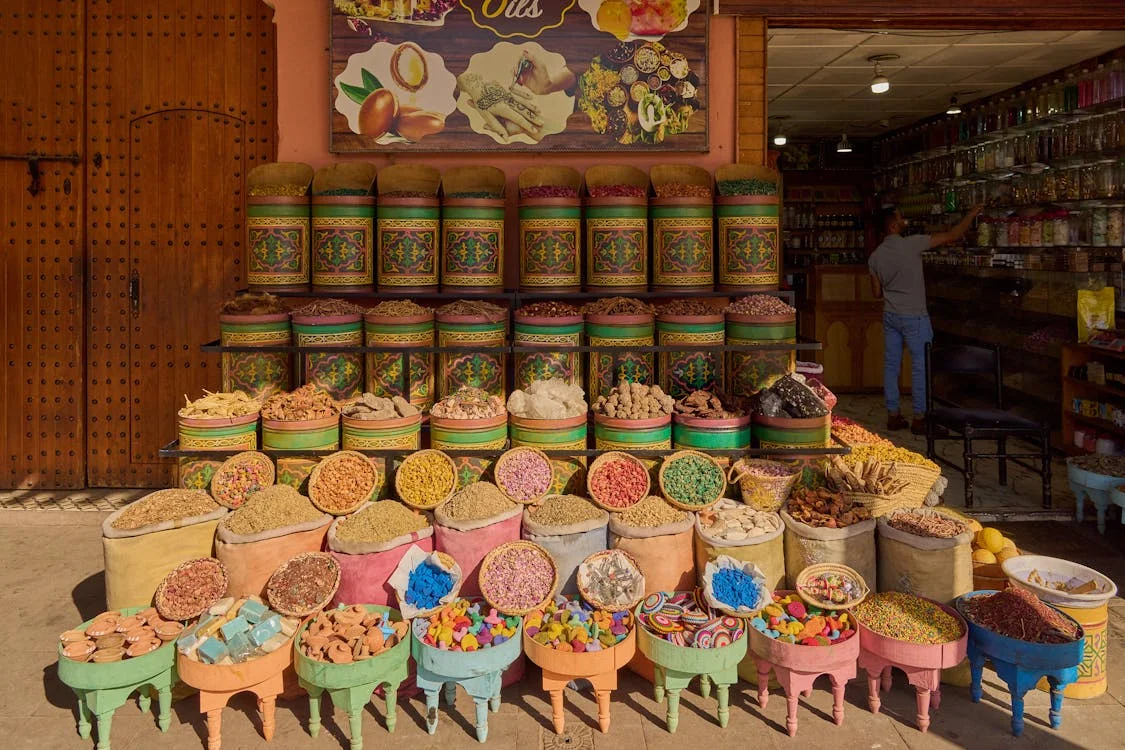
Image: Colorful display of Moroccan spices in a traditional souk market
I. The Allure of Moroccan Cuisine: A Fusion of Flavors and Traditions

Image: Traditional Moroccan dining
Morocco is a great place to visit. It has a long history, rich culture, beautiful scenery, and delicious food. Authentic Moroccan food is a mix of different traditions. Each dish tells a story filled with flavor and meaning. Berber recipes blend with ideas from Southern Europe and the Middle East. This mix has created a food style that is unique and loved by people all over the world.
Historical Influences on Traditional Moroccan Dishes
The development of Moroccan cuisine reflects the country’s strategic location and complex history:
- Berber foundations: The indigenous population contributed cooking techniques like tagine and essential ingredients such as olive oil, dates, and almonds
- Arab influences: Introduced spices, sweet-savory combinations, and sophisticated pastry techniques
- Mediterranean elements: Incorporated fresh vegetables, seafood, and citrus fruits
- French colonial impact: Added refinement to presentation and cooking techniques
This rich food tradition has shaped a cuisine that mixes old and new. Moroccan dishes are both familiar and full of flavor surprises. Meals are often shared with others, showing the country’s strong values of hospitality and community.
Spices: The Soul of Moroccan Flavor Profiles
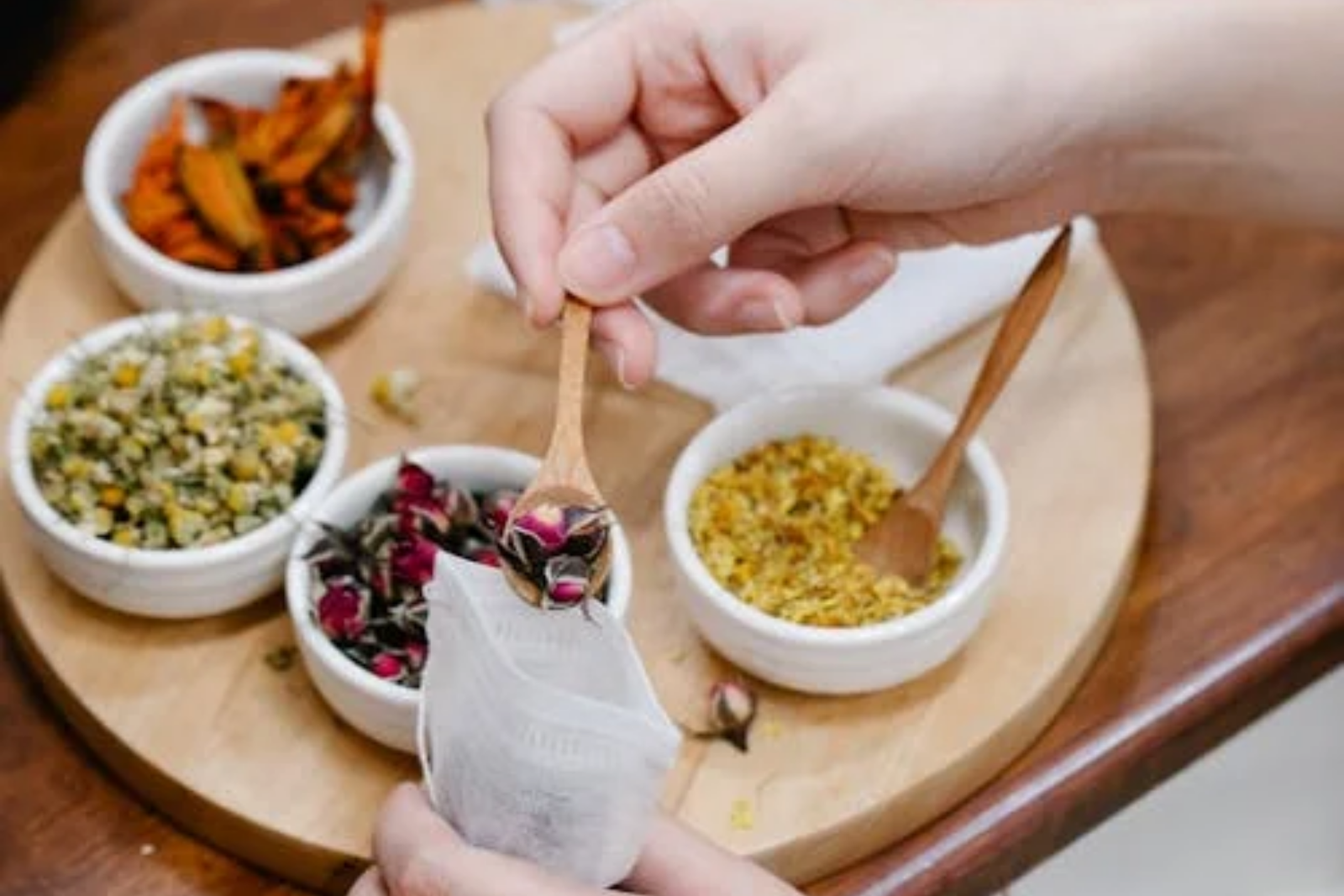
Image: Close-up of hands mixing a colorful Moroccan spice blend
It’s impossible to discuss Moroccan cuisine without highlighting spices, the beating heart of this food tradition. These skillfully balanced blends, passed down through generations, give each dish a unique identity and unparalleled depth of flavor. Understanding these spice combinations is key to appreciating the complexity of Moroccan cooking.
From Ras el hanout to red curry—Thailand’s vibrant food culture is equally spice-forward.
II. Essential Moroccan Spice Blends
The Moroccan spice blends that define the cuisine include:
Ras el Hanout: The Crown Jewel
This iconic blend can contain up to 30 different spices, including turmeric, pepper, cinnamon, and ginger. Often used in tagines, couscous, and stews, ras el hanout (which translates to “head of the shop”) represents a spice merchant’s finest blend. Each family and spice vendor typically has their own closely guarded recipe, making this blend a true reflection of Moroccan culinary artistry.
Everyday Spice Staples
Beyond ras el hanout, several key spices appear consistently in traditional Moroccan dishes:
- Cumin: One of the most common spices, used to season meats, vegetables, and soups like harira
- Cinnamon: Present in many sweet and savory dishes, such as pastilla and mrouzia
- Paprika: Often blended with other spices to marinate meats or enhance dishes like sardines with chermoula
- Saffron: Grown in southern regions, used to flavor prestigious dishes like chicken tagine with lemon confit
- Ginger: Essential for adding a spicy note to stews and soups
Other key spices include turmeric, coriander, and various herbs like mint and parsley, which are used fresh rather than dried in many recipes.
The Sensory Experience of Moroccan Spice Markets
Visiting a Moroccan spice market (souk) is a unique sensory adventure. In places like the Souq Semmarine in Marrakech, you’ll find an explosion of colors and aromas, with pyramids of cumin, stalls of golden turmeric, and jars filled with cloves and coriander seeds. These vibrant marketplaces offer real-time immersion into the building blocks of Moroccan flavor profiles.
Travel Tip: When purchasing spices, look for vendors who store their products away from direct sunlight to preserve freshness and potency. Additionally, many markets offer pre-mixed ras el hanout, which makes an excellent souvenir to recreate authentic Moroccan food at home.
III. Tagines: Morocco’s Iconic Slow-Cooked Masterpieces

Image: Steam rising from a traditional clay tagine pot with colorful vegetables visible
The tagine, another symbol of Moroccan cuisine, is much more than just a dish. Named after the distinctive conical earthenware pot in which it’s cooked, tagine represents both a cooking method and a diverse category of recipes that showcase the genius of Moroccan slow cooking.
Understanding Tagine: Vessel and Dish
The tagine vessel, typically made from earthenware, ceramic, or clay with a distinctive cone-shaped lid, serves a crucial function in Moroccan cooking. The design allows steam to circulate during cooking, condensing at the top and dripping back down to keep the contents moist. This natural self-basting process results in incredibly tender meat and vegetables infused with complex flavors.
For Moroccans, tagine recipes often represent social dishes, encouraging sharing and conviviality. They’re typically served directly from the cooking vessel, creating a theatrical dining experience.
Popular Moroccan Tagine Varieties
The versatility of the tagine is evident in its many popular variations:
- Chicken Tagine with Preserved Lemon and Olives: A Marrakech specialty featuring tangy preserved lemons and briny olives
- Lamb Tagine with Prunes and Almonds: A sweet-savory combination that exemplifies Moroccan flavor balancing
- Kefta Tagine: Featuring spiced meatballs in a tomato sauce, often topped with eggs
- Vegetarian Tagine: Rich in local vegetables, chickpeas, and spices
- Fish Tagine: Made with chermoula sauce, a vibrant herb and spice marinade
Each region of Morocco has its own tagine specialties, reflecting local ingredients and traditions. In coastal areas, you’ll find more seafood tagines, while inland regions favor meat varieties with dried fruits and nuts.
Culinary Insight: The key to an authentic tagine is patience—these dishes are traditionally cooked over very low heat for several hours, allowing the flavors to develop fully and the meat to become exceptionally tender.
France has its finesse, Morocco its flair—explore must-try French dishes for a Euro-style contrast.
IV. Beyond Tagine: Other Essential Moroccan Main Dishes
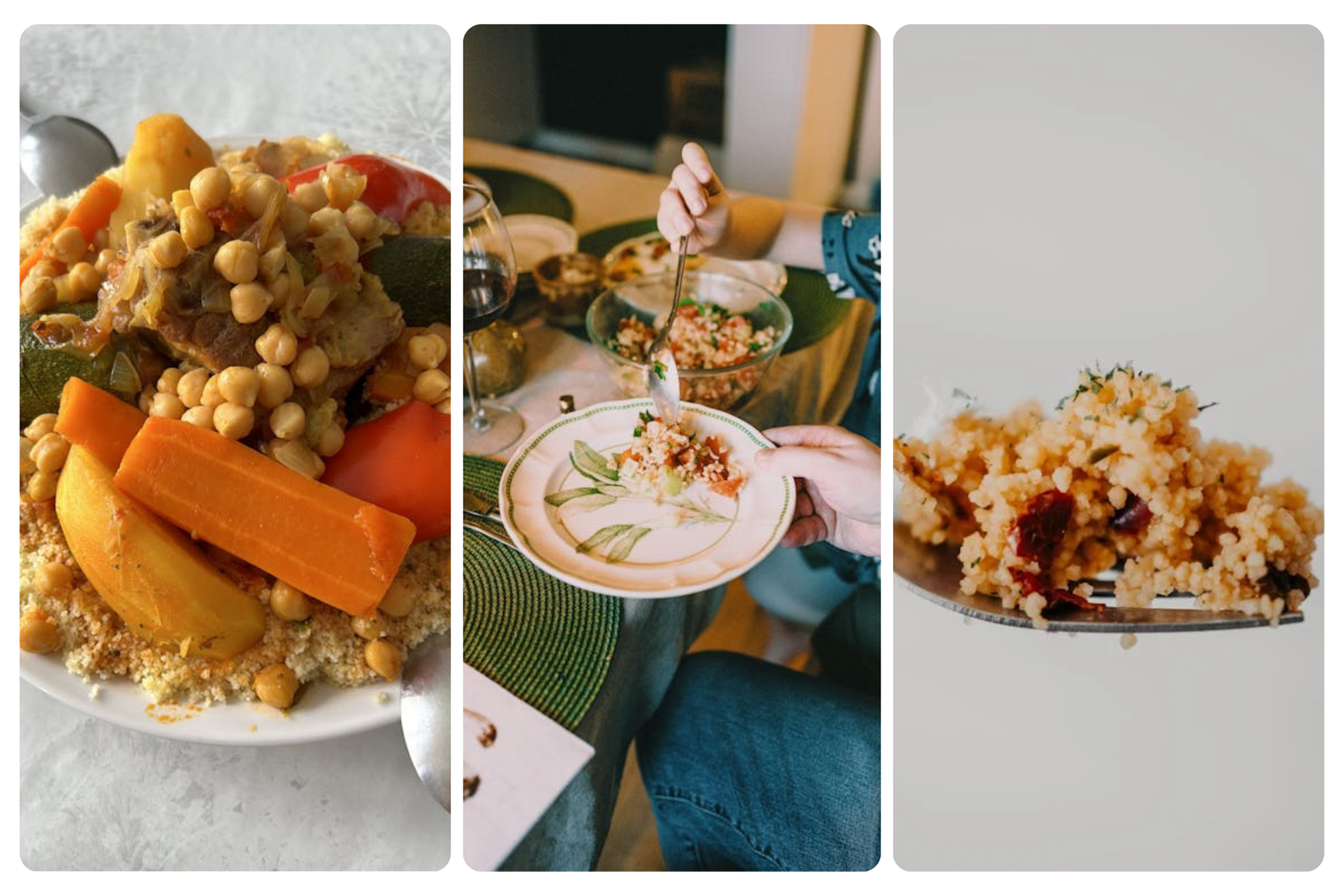
Image: Plate of fluffy couscous topped with vegetables and meat
While tagines might be the most internationally recognized Moroccan food, several other main dishes are equally important in the country’s culinary landscape.
Couscous: The National Dish of Morocco
Couscous holds such cultural significance that it’s traditionally prepared for Friday family gatherings. This dish consists of tiny steamed semolina granules topped with a flavorful stew of meat (typically lamb or chicken) and seven vegetables, symbolizing good luck.
The preparation of traditional couscous is labor-intensive, involving multiple steamings to achieve the perfect light and fluffy texture. The accompanying vegetables typically include carrots, pumpkin, zucchini, turnips, cabbage, chickpeas, and tomatoes, creating a colorful and nutritious meal.
Pastilla: Morocco’s Sweet and Savory Delicacy
Pastilla (also spelled bastilla or bestilla) represents the height of Moroccan culinary sophistication. This elaborate pie features layers of paper-thin pastry (warqa) filled with a mixture of pigeon or chicken, almonds, eggs, and spices, then dusted with powdered sugar and cinnamon. The contrast between the savory filling and sweet exterior exemplifies the Moroccan talent for balancing opposing flavors.
Originally from Fes, pastilla is now enjoyed throughout Morocco, particularly at celebrations and special occasions. The dish showcases Andalusian influences and is considered one of the most refined expressions of Moroccan cuisine.
Rfissa: Comfort Food with Cultural Significance
Rfissa combines shredded msemen (flatbread) or trid (thin pastry layers) with a richly spiced chicken and lentil stew, infused with fenugreek, ras el hanout, and other warming spices. Traditionally served to new mothers to aid recovery and increase milk production, this dish holds special cultural significance.
The preparation involves layering the bread at the bottom of a large dish and topping it with the fragrant stew, allowing the bread to soak up the flavorful sauce. This creates a comforting, one-dish meal that exemplifies Moroccan home cooking at its finest.
V. Moroccan Soups and Starters: Opening the Meal
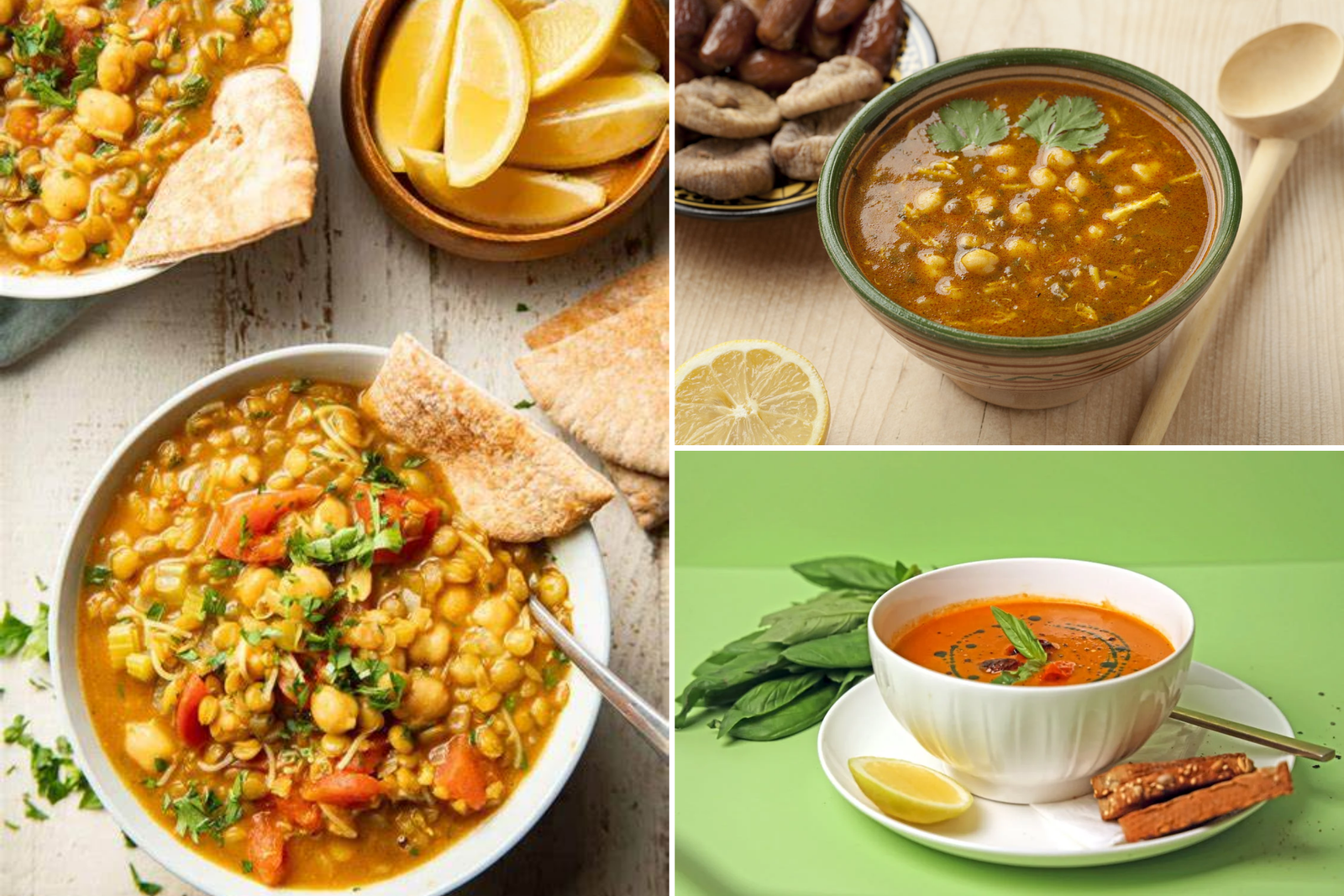
Image: Bowl of steaming harira soup with lemon wedges and dates on the side
Moroccan meals often begin with flavorful soups and salads that showcase fresh ingredients and complex spice combinations. These dishes set the stage for the main course while offering a taste of everyday Moroccan food culture.
Harira: The Iconic Moroccan Soup
Harira holds special significance during Ramadan, when it’s traditionally used to break the fast at sunset. This hearty tomato-based soup contains a nourishing mix of lentils, chickpeas, herbs, and small pieces of meat, finished with a squeeze of lemon juice and chopped cilantro.
The soup’s rich flavor comes from a blend of spices including cinnamon, ginger, turmeric, and pepper, creating a warming dish that’s both satisfying and nutritious. Often served with dates and chebakia (honey-soaked pastries), harira represents the perfect balance of flavors to revive the senses after a day of fasting.
B’ssara: Simple Yet Satisfying
At just a few dirhams a bowl, b’ssara (also spelled bissara) offers an affordable yet delicious taste of authentic Moroccan food. This rich soup made from dried broad beans is traditionally served for breakfast, topped with a swirl of olive oil, a sprinkling of cumin, and fresh bread.
Popular in northern Morocco, b’ssara exemplifies how simple ingredients can be transformed into something extraordinary through careful seasoning and slow cooking. During winter months, this warming soup becomes a staple in many Moroccan households.
Moroccan Salads: A Rainbow of Flavors
Moroccan meals typically include several small salads served at the beginning of the meal. Unlike Western-style raw salads, many Moroccan salad recipes feature cooked vegetables served either hot or cold. Popular varieties include:
- Zaalouk: A smoky eggplant and tomato mixture
- Taktouka: A flavorful blend of tomatoes, roasted green peppers, garlic, and spices
- Bakoula: Made with mallow leaves (or spinach), herbs, lemon, and olives
These salads are typically served with bread for scooping and provide a vibrant start to the meal with their array of colors, textures, and flavors.
Love layered flavors? Vietnamese cuisine offers a punchy, herbaceous contrast.
VI. Street Food Treasures: Morocco’s Casual Culinary Delights
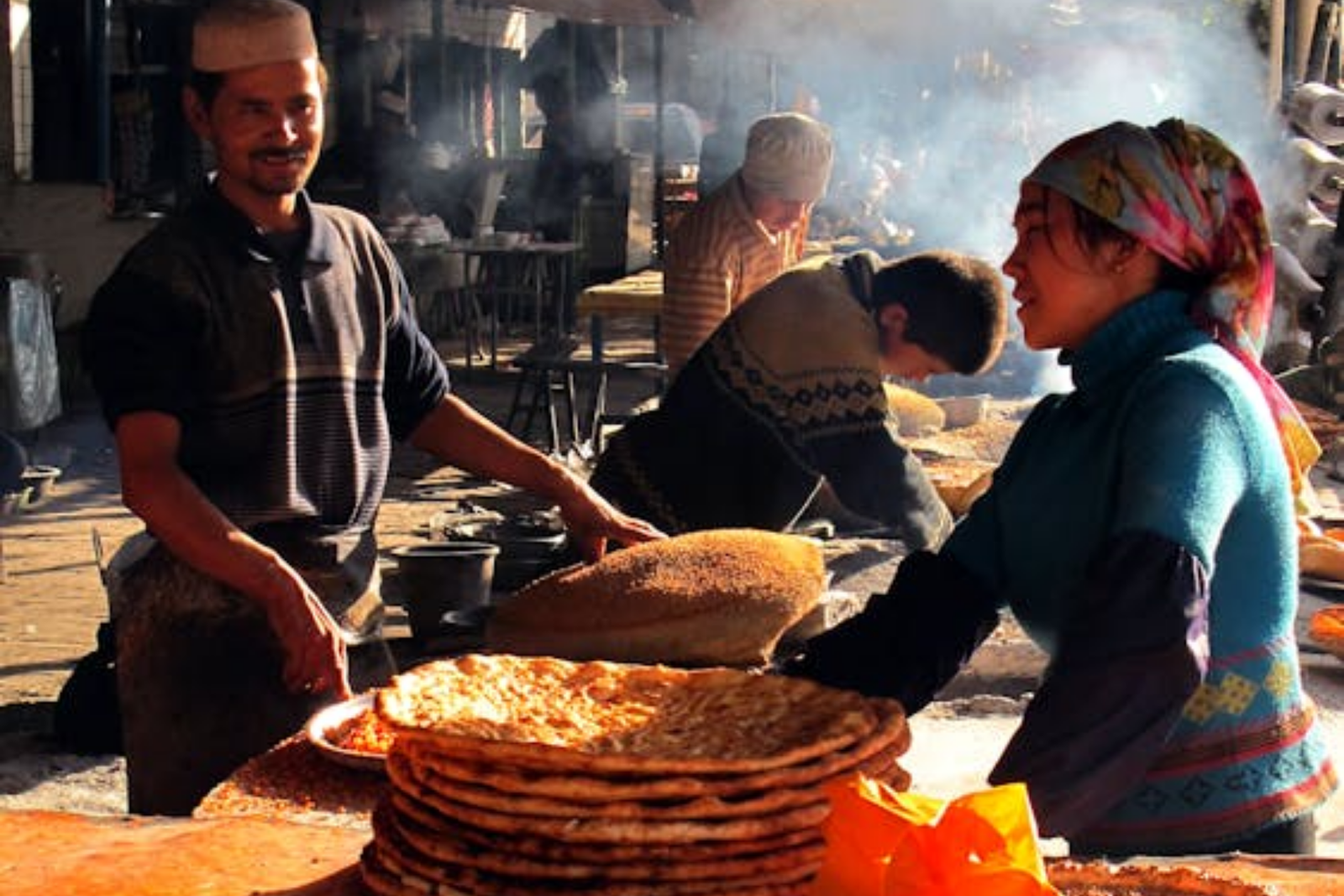
Image: Vendor preparing fresh msemen flatbread at a street food stall
From the bustling markets of Marrakech to the narrow alleys of Fes, Moroccan street food offers accessible, affordable, and delicious options for experiencing local flavors. These quick bites provide insight into everyday eating habits and represent some of the most beloved traditional Moroccan dishes.
Msemen: Morocco’s Beloved Flatbread
Msemen, a flaky, layered flatbread, is a staple breakfast and snack food throughout Morocco. Made from a simple dough of flour, water, and oil, msemen is rolled and folded to create its signature layers, then cooked on a hot griddle until golden and crispy.
Typically served with honey or jam for breakfast or stuffed with savory fillings like spiced onions or meat for a heartier meal, msemen showcases the Moroccan talent for creating extraordinary food from ordinary ingredients.
Makouda: Crispy Potato Fritters
Makouda (also spelled ma’quda) are crispy potato fritters that have become a street food favorite. Made from a simple mixture of mashed potatoes, onion, garlic, parsley, and spices, these delicious fritters are deep-fried until golden and often served in sandwich bread with harissa sauce.
Found in markets and street stalls throughout Morocco, makouda offers a satisfying and inexpensive taste of local cuisine. Their popularity speaks to the universal appeal of perfectly seasoned, crispy potatoes.
Sfenj: Moroccan Doughnuts
For those with a sweet tooth, sfenj provides the perfect street food treat. These Moroccan doughnuts are made from a sticky, unsweetened leavened dough that’s shaped into rings and deep-fried to perfection. Unlike Western doughnuts, sfenj has a chewy texture and is typically enjoyed plain or dusted with sugar rather than filled or glazed.
Often sold by street vendors in the morning, sfenj is commonly paired with mint tea or coffee for breakfast. Watching skilled vendors shape and fry these treats is part of the experience, demonstrating the artistry behind even the simplest Moroccan food.
VII. Sweet Conclusions: Moroccan Desserts and Pastries

Image: Assortment of Moroccan pastries
Moroccan meals often conclude with seasonal fruits rather than elaborate desserts, but the country’s pastry tradition is rich and varied. Moroccan desserts and pastries showcase the skilled use of honey, nuts, and floral waters, creating treats that are as beautiful as they are delicious.
Kaab el Ghzal: Gazelle Horns
Kaab el ghzal (gazelle horns) are crescent-shaped pastries filled with almond paste scented with orange flower water and cinnamon. The delicate pastry is typically decorated with intricate patterns before baking, resulting in a visually stunning treat that’s served at special occasions and with afternoon tea.
The name comes from their distinctive shape, which resembles gazelle horns. These pastries represent the refined side of Moroccan sweet-making, requiring skill and patience to create.
Chebakia: Ramadan’s Sweet Symbol
Chebakia (also spelled shebakia) are pretzel-shaped dough “roses” that are deep-fried, soaked in honey, and sprinkled with sesame seeds. These sticky, sweet treats are particularly associated with Ramadan, when they’re traditionally served alongside harira soup to break the fast.
The process of making chebakia is labor-intensive, involving folding and shaping the spiced dough before frying and soaking it in honey. The result is a chewy, sweet pastry with complex flavors from spices like anise, cinnamon, and saffron.
Sellou: Nutritious Indulgence
Sellou (also called sfouf) is a unique unbaked sweet made from toasted flour, ground almonds, sesame seeds, and spices, sweetened with honey or sugar. Often formed into a pyramid shape or served in small cups, sellou is both a dessert and a nutritious snack.
Traditionally prepared for special occasions like Ramadan and to celebrate new births, sellou is valued for its nutritional benefits as well as its rich, nutty flavor. The combination of nuts, seeds, and honey makes it particularly energizing—perfect for sustaining energy during Ramadan.
🐪 Planning a cultural deep dive? Check out our guide to solo travel in Africa — Morocco makes the perfect starting point for your adventure.
VIII. The Essential Beverage: Mint Tea – Morocco’s Liquid Hospitality
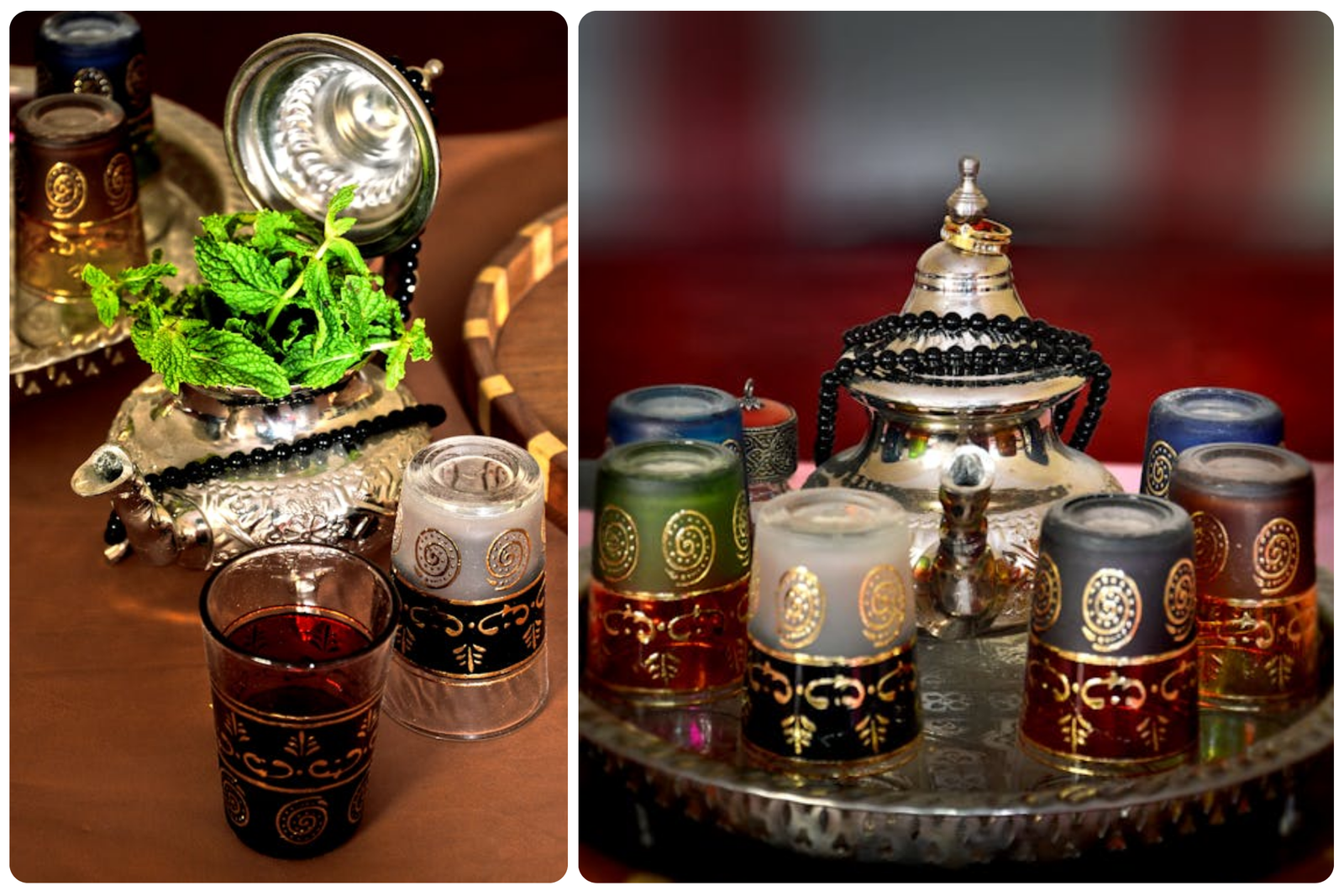
Image: Traditional Moroccan tea service with silver teapot and decorated glasses
No exploration of Moroccan food culture would be complete without mentioning mint tea, often referred to as “Moroccan whisky.” This sweet and refreshing drink represents the pinnacle of Moroccan hospitality and is the country’s national beverage.
The Art of Moroccan Tea Preparation
Preparing Moroccan mint tea is a ceremonial process, particularly when guests are present. The traditional method involves:
- Rinsing Chinese gunpowder green tea leaves in boiling water
- Adding fresh mint leaves and a generous amount of sugar
- Pouring the tea from a height to create a frothy “crown”
- Serving three rounds of tea, following the proverb: “The first glass is as gentle as life, the second is as strong as love, the third is as bitter as death”
The tea is typically served in small, decorative glasses and offered to guests as a welcome gesture. Refusing tea can be considered impolite, as it represents the host’s hospitality.
Cultural Insight: The tea ceremony often serves as a prelude to business discussions or social gatherings, creating a relaxed atmosphere for conversation. The care taken in preparation demonstrates respect for guests and tradition.
IX. Practical Tips for Exploring Moroccan Cuisine

Image: Travelers enjoying a cooking class learning to prepare Moroccan dishes
To fully appreciate the best local foods to try in Morocco, consider these practical tips for culinary exploration:
Where to Find Authentic Moroccan Food
- Traditional Riads: Many guesthouses offer home-cooked meals that showcase family recipes
- Local Restaurants: Look for places filled with Moroccans rather than tourists
- Street Food Markets: Jemaa el-Fnaa in Marrakech transforms into a food paradise at night
- Cooking Classes: Learn to prepare traditional Moroccan dishes yourself
- Home Invitations: If you’re fortunate enough to be invited to a Moroccan home, accept—this is where the most authentic food is found
Dining Etiquette in Morocco
Understanding local customs enhances your dining experience:
- Meals are typically eaten with the right hand, using bread to scoop up food
- It’s customary to wash hands before and after meals (a server will often come around with soap, water, and towels)
- Communal dishes are eaten from your “section” of the plate—don’t reach across to the other side
- Complimenting the food is appreciated and expected
- Leaving a small amount of food indicates you’re satisfied; finishing everything suggests you’re still hungry
Dietary Considerations
- Halal: Most meat in Morocco is halal (prepared according to Islamic law)
- Vegetarians: While meat is prominent, many vegetable tagines, salads, and couscous dishes are available
- Allergies: Be specific about allergies, particularly nuts which are common in Moroccan cooking
- Alcohol: Available in some restaurants and hotels catering to tourists, but not in traditional establishments
👉 Want to plan your foodie adventure around Morocco’s top destinations?
Check out the official Morocco Tourism Board website for inspiration and travel tips.
X. Conclusion: A Culinary Journey Worth Savoring
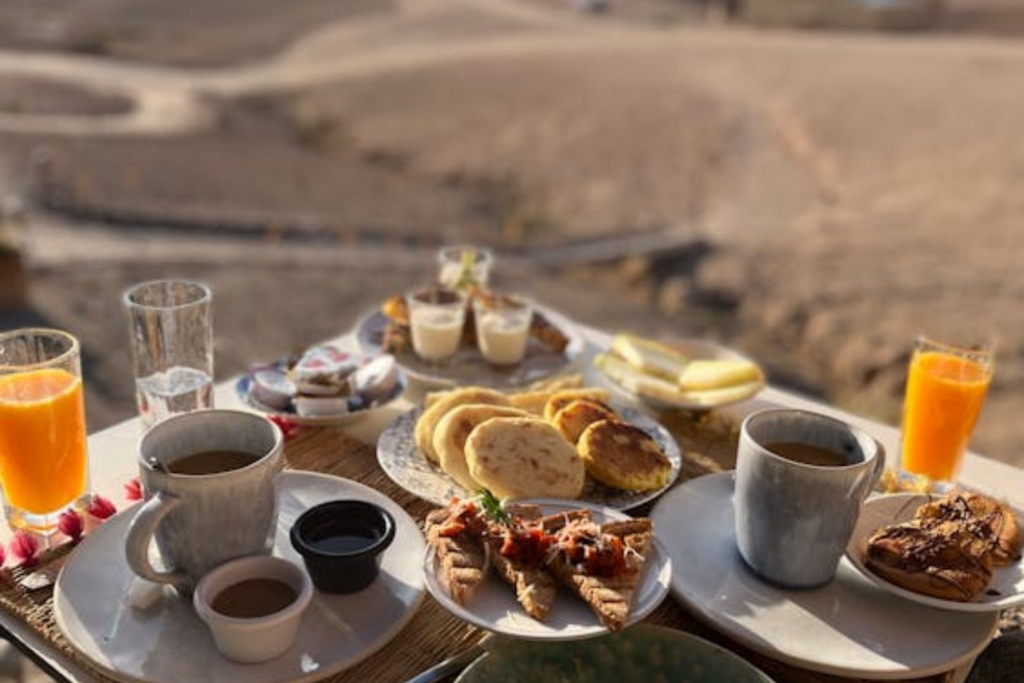
Image: Moroccan breakfast
Moroccan gastronomy stands as a testament to the country’s rich history and cultural influences, offering a vibrant tapestry of flavors and aromas. From the intricate spice blends to the slow-cooked tagines and the delightful sweet treats, each dish provides a unique insight into Moroccan culture and tradition.
The best local foods to try in Morocco go beyond mere sustenance—they tell stories of cultural exchange, family traditions, and the ingenious use of local ingredients. By exploring these culinary concepts, you gain a deeper appreciation for the art of blending diverse elements to create something truly exceptional.
Whether you’re planning a trip to Morocco or simply seeking culinary inspiration, the country’s food traditions offer rich insights and unforgettable flavors. As you navigate Morocco’s medinas and markets, remember that each meal is an opportunity to connect.

Image: Screenshot of the GoHub eSIM webpage, highlighting the destination input field with “Morocco” selected, illustrating how users can easily search for eSIM data plans.
📶 Whether you’re browsing souks or navigating medinas, stay connected across Morocco with a hassle-free travel eSIM — prepaid, instant, and no local SIM drama.
Bold flavors unite! Mexican cuisine is another journey worth taking if you love strong taste.








